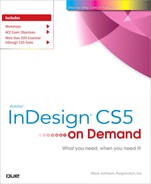1. Getting Started with InDesign CS5
Introduction
Adobe InDesign CS5 is a desktop publishing and page layout program that runs seamlessly on both Windows and Macintosh platforms. Adobe InDesign CS5 is a stand-alone program, but it’s also part of Adobe’s Creative Suite of professional programs that work together to help you create designs in print, on the Web, or on mobile devices. Many of the Creative Suite 5 programs also include additional Adobe programs and services—Bridge, CS Live, ConnectNow, Device Central, Extension Manager, and ExtendScript Toolkit—to help you manage and work with files.
With InDesign, you can create books, brochures, catalogs, manuals, CD-DVD labels, certificates, newsletters, flyers, forms, label sheets, and even interactive presentations. As a page layout program, you can create a one page flyer, a 500 or more page book, or something in between. InDesign provides all the tools you need to create a page layout design, import or enter text, insert images, add drawings, create tables, and finalize the document. When you’re done, you can print the document to a local desktop or commercial printer, create a template, so you can reuse the document again later for a new project, or export the document as an Adobe PDF (Portable Document Format) or Digital Edition for use online or over a network, or for use in other programs, such as Adobe Flash (FLA or SWF) or Adobe Dreamweaver.
Installing InDesign
The process of installing the InDesign application is fairly straightforward; you insert the InDesign CS5 install disc into your DVD drive or download the software online to your computer, double-click the setup program and simply follow the on-screen instructions. The first thing that will happen is that the installer will check to see if you have the minimum system requirements. If you meet the minimums, the installer will guide you through the steps to complete the installation. The whole process takes about ten minutes, and at the end of the process you can launch InDesign for the first time. Remember to have your serial number handy, because you will have to type it in during the installation process. It’s a good idea to have that serial number in a safe place, just in case you would need to reinstall InDesign.
Install InDesign CS5 in Windows
![]() Insert the InDesign CS5 DVD into your DVD ROM drive, or download the software online to your hard disk.
Insert the InDesign CS5 DVD into your DVD ROM drive, or download the software online to your hard disk.
![]() If necessary, double-click the DVD icon or open the folder with the downloaded software, and then double-click the setup icon.
If necessary, double-click the DVD icon or open the folder with the downloaded software, and then double-click the setup icon.
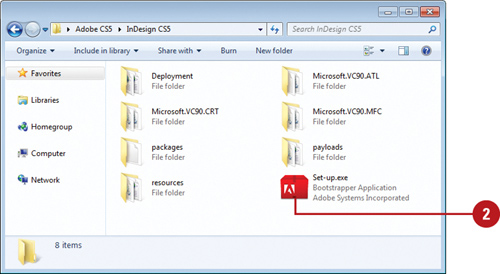
![]() Follow the on-screen instructions to install the product; the installer asks you to read and accept a licensing agreement, enter a serial number, indicate the language you want, enter or create an Adobe ID or skip the step, and specify where you want to install the software.
Follow the on-screen instructions to install the product; the installer asks you to read and accept a licensing agreement, enter a serial number, indicate the language you want, enter or create an Adobe ID or skip the step, and specify where you want to install the software.

Did You Know?
The DVD comes with bonus content. The Resources and Extras DVD included with Adobe CS5 products includes bonus content and files in the Goodies folder. Check it out! For more free online resources, go to www.adobe.com and visit Adobe Exchange.
Install InDesign CS5 in Macintosh
![]() Insert the InDesign CS5 DVD into your DVD ROM drive, or download the software online to your hard disk.
Insert the InDesign CS5 DVD into your DVD ROM drive, or download the software online to your hard disk.
![]() If necessary, double-click the DVD icon or open the folder with the downloaded software, and then double-click the Install icon.
If necessary, double-click the DVD icon or open the folder with the downloaded software, and then double-click the Install icon.
![]() Follow the on-screen instructions to install the product; the installer asks you to read and accept a licensing agreement, enter a serial number, indicate the language you want, enter or create an Adobe ID or skip the step, and specify where you want to install the software.
Follow the on-screen instructions to install the product; the installer asks you to read and accept a licensing agreement, enter a serial number, indicate the language you want, enter or create an Adobe ID or skip the step, and specify where you want to install the software.

Did You Know?
Most Adobe applications can be downloaded. It’s all very simple, you go to www.adobe.com, click the Products menu item, and then select the application you want to purchase. You will need a credit card (of course), and a lot of bandwidth.
Getting Started
You can start InDesign in several ways, depending on the platform you are using. When you start InDesign, the software displays a Welcome screen and then the InDesign window. When you start a new InDesign session or close all documents, a Welcome screen appears in the InDesign window, providing easy access links to open a file, open a recent file, create a new file, and create a new file from a template. You can also use links to access help information, such as Getting Started, New Features, and online Community resources, such as the InDesign Exchange web site, where you can download additional applications and information, and Adobe CS Live online services (New!).
Start InDesign CS5 in Windows
![]() Click Start on the taskbar.
Click Start on the taskbar.

![]() Point to All Programs (which changes to Back).
Point to All Programs (which changes to Back).
![]() Point to an Adobe Collection CS5 menu, if needed.
Point to an Adobe Collection CS5 menu, if needed.
![]() Click Adobe InDesign CS5.
Click Adobe InDesign CS5.
![]() If you’re starting InDesign CS5 for the first time, you might be prompted to specify the following:
If you’re starting InDesign CS5 for the first time, you might be prompted to specify the following:
• Enter or create an Adobe ID to register the product, click Submit, and then click Done.
The InDesign window opens, displaying the Welcome screen.

Did You Know?
You can create and use a shortcut icon on your desktop to start InDesign (Win). Click Start on the taskbar, point to All Programs, right-click Adobe InDesign CS5, point to Send To, and then click Desktop (Create Shortcut). Double-click the shortcut icon on your desktop to start InDesign.
Start InDesign CS5 in Macintosh
![]() Open the Applications folder (located on the main hard drive).
Open the Applications folder (located on the main hard drive).
![]() Double-click the Adobe InDesign CS5 folder.
Double-click the Adobe InDesign CS5 folder.
![]() Double-click the Adobe InDesign CS5 program icon.
Double-click the Adobe InDesign CS5 program icon.


![]() If you’re starting InDesign CS5 for the first time, you might be prompted to specify the following:
If you’re starting InDesign CS5 for the first time, you might be prompted to specify the following:
• Enter or create an Adobe ID to register the product, click Submit, and then click Done.
The InDesign window opens, displaying the Welcome screen.
Did You Know?
You can create a shortcut on the Macintosh. Drag and drop the InDesign application to the bottom of the monitor screen, and then add it to the dock.
You can create and use a keyboard shortcut to start InDesign (Win). Click Start on the taskbar, point to All Programs, right-click Adobe InDesign CS5, and then click Properties. In the Shortcut Key box, type or press any letter, number, or function key, such as P, to which Windows adds Ctrl+Alt. Click OK to create the keyboard shortcut. From anywhere in Windows, press the keyboard shortcut you defined (Ctrl+Alt+P) to start InDesign.
Viewing the InDesign Window
When you start InDesign, the program window displays several windows of varying types you can use to work with documents. In InDesign, windows appear in the workspace in panels. A panel is a window you can collapse, expand, and group with other panels, known as a panel group, to improve accessibility and workflow. A panel group consists of either individual panels stacked one on top of the other or related panels organized together with tabs to navigate from one panel to another.
The Tools panel contains a set of tools you can use to create shapes, such as lines, rectangles, and ellipses. You can fill and stroke shapes and text with different colors and stroke widths. When you select a tool, additional options appear on the Control panel.
A menu is a list of commands that you use to accomplish specific tasks. A command is a directive that accesses a feature of a program. InDesign has its own set of menus. The Application bar provides easy access to commonly used features, such as choosing zoom levels, view options, screen mode, document arrangement, workspaces, and InDesign’s community online Help.
The Document window displays open InDesign documents. InDesign includes tabs to make it easier to switch back and forth between documents and a close button to quickly close a document.

Showing and Hiding Panels
Panels give you easy access to many task-specific commands and operations from color control to vector path information. By default, the main panel display is located along the right side of your window. You can use the Window menu or click a panel tab within a group to display it, and then select options on the panel or choose panel-specific commands from the Panel Options menu to perform actions. Instead of continually moving, resizing, or opening and closing windows, you can use the header bar with the panel tabs to collapse or expand individual panels within a window to save space.
Open and Close a Panel
![]() Click the Window menu.
Click the Window menu.
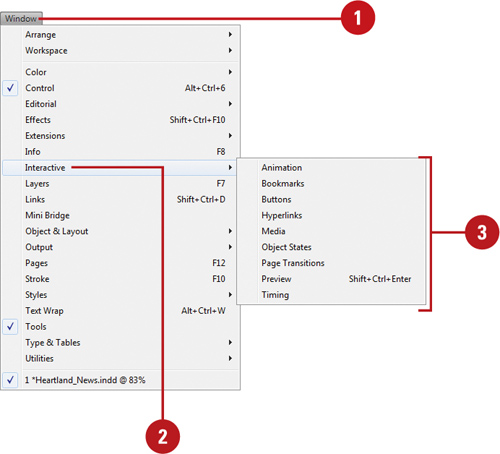
![]() Point to a submenu (if needed), such as Color, Editorial, Extensions, Interactive, Object & Layout, or Type & Tables.
Point to a submenu (if needed), such as Color, Editorial, Extensions, Interactive, Object & Layout, or Type & Tables.
![]() Click a panel name, such as Animation, Color, Layers, or Swatches.
Click a panel name, such as Animation, Color, Layers, or Swatches.
Timesaver
To close a panel, or a single tab, right-click (Win) or control-click (Mac) a panel tab, and then click Close Tab Group or Close (for a single tab). On the Mac, you can also click the Close button on the panel.
Collapse or Expand a Panel
![]() To collapse or expand an open panel, click the dark gray area or double-click a title tab on the header bar of the panel.
To collapse or expand an open panel, click the dark gray area or double-click a title tab on the header bar of the panel.

If the panel is in icon mode, click on the icon to expand or collapse it. To reduce the panel back to icon mode, click on the double right-facing arrows in the dark gray area. To expand from icons to panels, click on the double left facing arrows.
Working with Panels
The movable panels are organized into groups, such as Stroke/Color and Pages/Links, to save screen space and help with workflow. You can also dock (add) or undock (subtract) specific panels within a group to customize your workspace. A panel appears with a header, which includes the tab titles and three options: the Collapse To Icons or Expand Panels button, the Close button, and an Options menu. The Options menu provides you with panel commands. The entire set of panels includes a double arrow at the top you can use to collapse and expand the entire panel back and forth between icons and full panels.
Dock a Panel
![]() Select a panel; click on a named panel, or click the Window menu, and then click a panel name.
Select a panel; click on a named panel, or click the Window menu, and then click a panel name.

![]() Drag the panel away from the group to another panel.
Drag the panel away from the group to another panel.
• Add to Panel Group. Drag to a panel group until a blue rectangle appears around the panel.
• Append to Panel. Drag to a panel until a blue line appears along the side of the panel.
Undock a Panel
![]() Select a panel; click on a named panel, or click the Window menu, and then click a panel name.
Select a panel; click on a named panel, or click the Window menu, and then click a panel name.

![]() Drag the panel out of the group.
Drag the panel out of the group.
![]() Drop it onto the InDesign window.
Drop it onto the InDesign window.
Did You Know?
You can dock and undock panels to a docking channel. You can dock and undock, panels or panel groups in docking channels. A docking channel is a region located on the left and right side of the InDesign window to which you can attach and detach panels. When you drag a panel over a dockable area, a blue line appears.
Collapse and Expand the Panel Set Between Icons and Panels
• To collapse the panel set to icons with text, click the double arrow pointing right (Collapse to Icons) at the top of the panels.

• To expand the panel set from icons with text to full panels, click the double arrow pointing left (Expand Panels) at the top of the panels.
• To have an expanded panel icon automatically collapse or hide when you click away, right-click (Win) or Control-click (Mac) a panel, and then click Auto-Collapse Iconic Panels or Auto-Show Hidden Panels.
Use the Panel Options Menu
![]() Open or expand a panel.
Open or expand a panel.
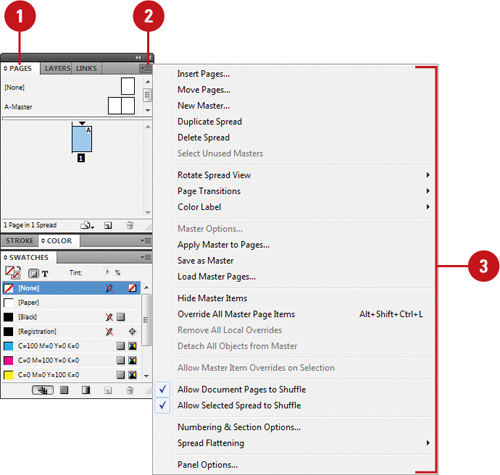
![]() Click the Options button on the right side of the panel header bar.
Click the Options button on the right side of the panel header bar.
![]() Click a command from the list (commands vary).
Click a command from the list (commands vary).
Did You Know?
You can temporarily hide all of InDesign’s panels and Tools panel. Press the Tab key to hide the panels. Press the Tab key a second time to display the hidden panels. Hold down the Shift key, and then press the Tab key to hide the panels, but not the Tools and Control panels.
Using the Tools and Control Panel
InDesign has an abundance of tools that give an InDesign designer tremendous control over any creative designing problems that may crop up. For example, the InDesign tool-box contains a variety of different tools: selection tools (you can never have enough selection tools), drawing or shape tools, type tools, and other tools dedicated to creating documents, transforming objects, and working with pages. Add viewing tools and you have everything you need to do any job.
When you work on a document, it’s important to know what tools are available, and how they can help in achieving your design goals. InDesign likes to save space, so it consolidates similar tools under one button. To access multiple tools, click and hold on any Tools panel button that contains a small black triangle, located in the lower right corner of the tool button. Take a moment to explore the InDesign toolbox and get to know the tools.

The InDesign Tools panel contains the tools needed to work through any InDesign job, but it’s not necessary to click on a tool to access it. Simply using a letter of the alphabet can access all of InDesign’s tools. For example, pressing the P key switches to the Pen tool, and pressing the T key switches to the Type tool. If you’re not sure what letter to press, you can use the Tools Hints panel (New!), which lists all the hidden modifier keys available for the currently selected tool. Click the Window menu, point to Utilities, and then click Tool Hints (New!). If you prefer a complete list of letter assignments for all the tools, you can refer to Adobe InDesign CS5 Keyboard Shortcuts (available for download on the Web at www.perspection.com). You can temporarily switch from the current tool to any other tool by holding down the appropriate letter key. As you hold down the key, your current tool changes to the new tool, and when you release it, you return to the previous tool (New!). To really get efficient in InDesign, you need to learn to use both hands. Use one hand for your mouse or drawing tablet, and the other on the keyboard to make quick changes of tools and options. Think of using InDesign like playing a piano—you need to use both hands.
Using the Control Panel
The Control panel displays the options for the currently selected tool. For most tools, your options include X and Y Location, W and H dimensions, Scale X and Y, Rotation and Shear Angle, Rotate and Flip, Fill and Stroke Color (New!), Stroke Weight and Style, Apply Effect, Opacity, Drop Shadow, Quick Apply, and the Options menu. The important thing to remember is that the Control panel is customized based on the tool you have selected, so options will vary.


Opening a Document
InDesign lets you open document files created in different formats, such as InDesign (INDD), InDesign CS3 Interchange (INX), InDesign Markup (IDML), PageMaker (6.0-7.0), and QuarkXPress (3.3-4.1x). If you want to simply open an InDesign document, the Welcome Screen or Open dialog box are the most efficient ways. However, if you need to manage, organize, or process files, Adobe Bridge is the way to go. You open an existing InDesign document file the same way you open documents in other programs. In Windows Explorer (Win) or Finder (Mac), you can double-click an InDesign document to open the InDesign program and the document. When you open a document, a tab appears across the top of the Document window, with the document title. When you open an InDesign CS4 document, the document tab includes “[Converted],” which you can save to update it to InDesign CS5. You can click the tab at any time to display that particular document.
Open an Existing Document
![]() Click the File menu, and then click Open to display all file types in the file list of the Open dialog box.
Click the File menu, and then click Open to display all file types in the file list of the Open dialog box.
![]() Click the Files of Type (Win) or Enable (Mac) list arrow, and then select a format.
Click the Files of Type (Win) or Enable (Mac) list arrow, and then select a format.
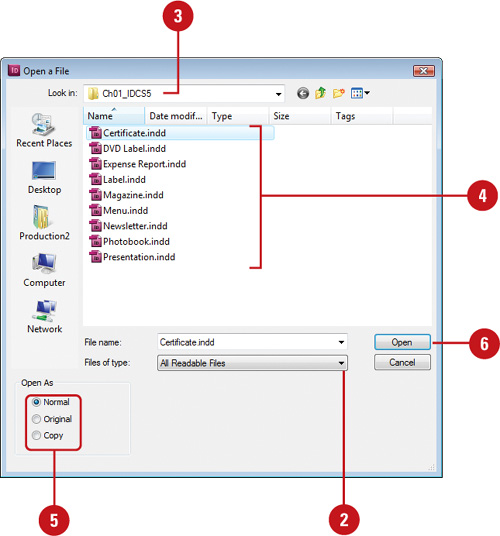
Select All Readable Files to display all files that can be opened in InDesign.
![]() Navigate to the location with the document you want to open.
Navigate to the location with the document you want to open.
![]() Click the file you want to open.
Click the file you want to open.
Timesaver
Press and hold the Shift key to select multiple contiguous files to open while in the Open dialog box.
![]() Click the Normal (original document or copy of a template), Original (original document or template), or Copy (copy of a document or template) option.
Click the Normal (original document or copy of a template), Original (original document or template), or Copy (copy of a document or template) option.
![]() Click Open.
Click Open.
![]() If an alert appears for missing fonts or links, select an option, and then click OK or another button.
If an alert appears for missing fonts or links, select an option, and then click OK or another button.
Open a Recently Opened Document
![]() Click the File menu, and then point to Open Recent.
Click the File menu, and then point to Open Recent.

![]() Click the document you want to open.
Click the document you want to open.
Did You Know?
You can open a recent file quickly from the Start menu (Win). Click the Start button, point to Adobe InDesign CS5 (7), Recent Items (Vista) or My Recent Documents (XP), and then click the file name you want to open.
Open a Document from the Welcome Screen
![]() Start Adobe InDesign or click the Help menu, and then click Welcome Screen.
Start Adobe InDesign or click the Help menu, and then click Welcome Screen.
![]() Click a document from the Open a Recent Item list.
Click a document from the Open a Recent Item list.
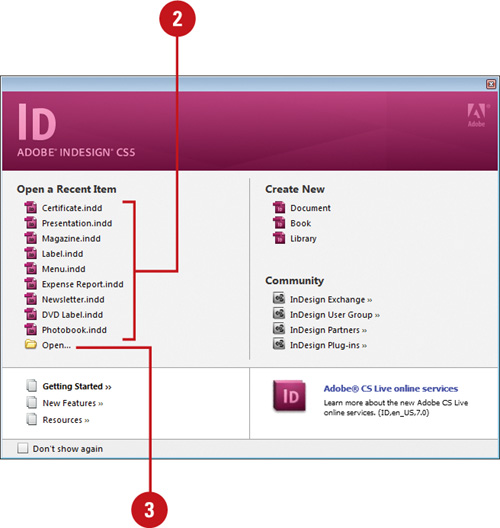
![]() To open a document not in the list, click Open, select a document, and then click Open.
To open a document not in the list, click Open, select a document, and then click Open.
Did You Know?
You can delete a file in a dialog box (Win). In the Open or Save As dialog box, right click the file you want to delete, and then click Delete.
Opening a Document with Adobe Bridge
With Adobe Bridge, you can drag assets into your layouts as needed, preview them, and add metadata to them. Bridge allows you to search, sort, filter, manage, and process files one at a time or in batches. You can also use Bridge to create new folders; rename, move, delete and group files (known as stacking); edit metadata; rotate images; and run batch commands. You can also view information about files and data imported from your digital camera.
Browse and Open Documents with Adobe Bridge
![]() Click the Go to Bridge button on the Application bar or click the File menu, and then click Browse in Bridge.
Click the Go to Bridge button on the Application bar or click the File menu, and then click Browse in Bridge.

![]() In Bridge, select a specific workspace to view your files the way you want.
In Bridge, select a specific workspace to view your files the way you want.
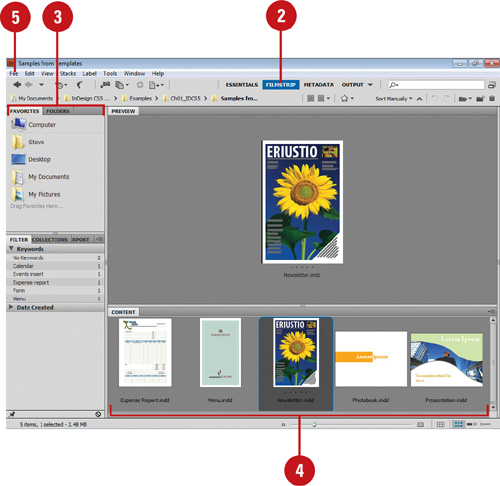
![]() Navigate to the location with the file you want to open.
Navigate to the location with the file you want to open.
![]() To open an image in InDesign, use any of the following:
To open an image in InDesign, use any of the following:
• Double-click on a thumbnail to open it in the default program.
• Drag the thumbnail from the Bridge into an open Adobe application.
• Select a thumbnail, click the File menu, point to Open With, and then click Adobe InDesign CS5.
• Select a thumbnail, click the File menu, point to Place, and then click In InDesign.
![]() To return to InDesign, click the File menu, and then click Return to Adobe InDesign.
To return to InDesign, click the File menu, and then click Return to Adobe InDesign.
Work with Files Using Bridge
![]() Click the Go to Bridge button on the Application bar or click the File menu, and then click Browse in Bridge.
Click the Go to Bridge button on the Application bar or click the File menu, and then click Browse in Bridge.

![]() Click the Folders tab and choose a folder from the scrolling list.
Click the Folders tab and choose a folder from the scrolling list.
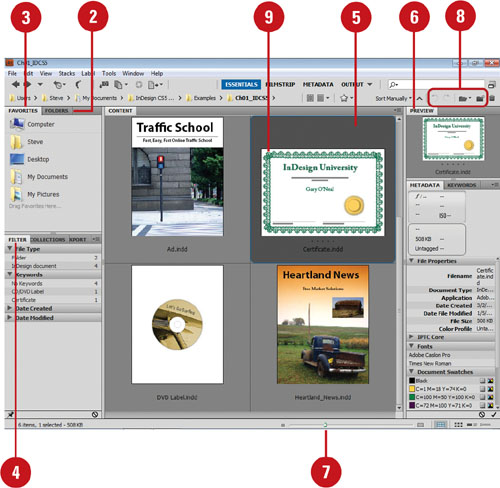
![]() Click the Favorites tab to choose from a listing of user-defined items, such as Pictures.
Click the Favorites tab to choose from a listing of user-defined items, such as Pictures.
![]() To narrow down the list of images using a filter, click the criteria you want to use in the Filter panel.
To narrow down the list of images using a filter, click the criteria you want to use in the Filter panel.
![]() Click an image within the preview window to select it.
Click an image within the preview window to select it.
![]() Click the Preview tab to view a larger thumbnail of the selected image. Multiple images appear when you select them.
Click the Preview tab to view a larger thumbnail of the selected image. Multiple images appear when you select them.
![]() Drag the Zoom slider to increase or decrease the thumbnail views.
Drag the Zoom slider to increase or decrease the thumbnail views.
![]() Use the file management buttons to rotate or delete images, or create a new folder.
Use the file management buttons to rotate or delete images, or create a new folder.
![]() Double-click on a thumbnail to open it in the default program, or drag the thumbnail from the Bridge into an open Adobe application.
Double-click on a thumbnail to open it in the default program, or drag the thumbnail from the Bridge into an open Adobe application.
• When you drag the thumbnail to an InDesign document, the place cursor appears, where you can insert the image where you want and create the frame size you want (New!).
Did You Know?
You can reveal a document in Adobe Bridge from InDesign. Open a document in InDesign, click the Open icon (looks like a piece of paper with edge folded over) on the Status Bar, and then click Reveal In Bridge.
Inserting Images or Text in a Document
You can use InDesign’s Place command to insert artwork into an open document. To increase your control of the new image, InDesign allows you to use the place cursor to create a frame with the size you want on the active layer. InDesign lets you place files saved in InDesign, Media Files, Images, Adobe PDF, EPS, MS Excel or Word, and TXT formats to name a few. When you place a vector-based image, you have the ability to modify the width, height, and rotation while retaining the vector format. When you insert an image, you can also create a caption (New!).
Insert an Image or Text in a Document
![]() Open an InDesign document.
Open an InDesign document.
![]() Click the File menu, and then click Place.
Click the File menu, and then click Place.
![]() Navigate to the location with the image, and then select the image you want to place into the active document.
Navigate to the location with the image, and then select the image you want to place into the active document.

![]() Select any of the following options:
Select any of the following options:
• Show Import Options. Select to specify import options for the imported item.
• Replace Selected Item. Select to replace the currently selected item on the page.
• Create Static Captions. Select to create a static text caption using the title of the file (New!).
![]() Click Open.
Click Open.
![]() If you selected the Show Import Options check box, specify the Import options that you want, and then click OK. If not, click or drag the place cursor to insert the image. If you selected the Create Static Captions check box, click or drag to create a text box.
If you selected the Show Import Options check box, specify the Import options that you want, and then click OK. If not, click or drag the place cursor to insert the image. If you selected the Create Static Captions check box, click or drag to create a text box.

InDesign places the image in the active layer, and then encloses it within a frame.
![]() Adjust the Scale X and Scale Y values on the Control panel to resize the placed image.
Adjust the Scale X and Scale Y values on the Control panel to resize the placed image.

Using the Status Bar
To work efficiently in InDesign you need information about the active document. Details about the document’s preflight profile can help in the design and preparation of the final document. You can quickly enable the current or all open documents as preflight documents. In addition, you can open the Preflight panel or Preflight Profile dialog box to view and set preflight options. From the Status Bar, you can also switch between pages.
Use the Status Bar
![]() Click the triangle (Preflight menu) near the Status bar info box, and then select from the following options:
Click the triangle (Preflight menu) near the Status bar info box, and then select from the following options:
• Preflight Panel. Opens the Preflight panel.
• Define Profiles. Opens the Preflight Profiles dialog box.
• Preflight Document. Enables or disables the current document as a preflight document.
• Enable Preflight for All Documents. Enables or disables all open documents as preflight documents.
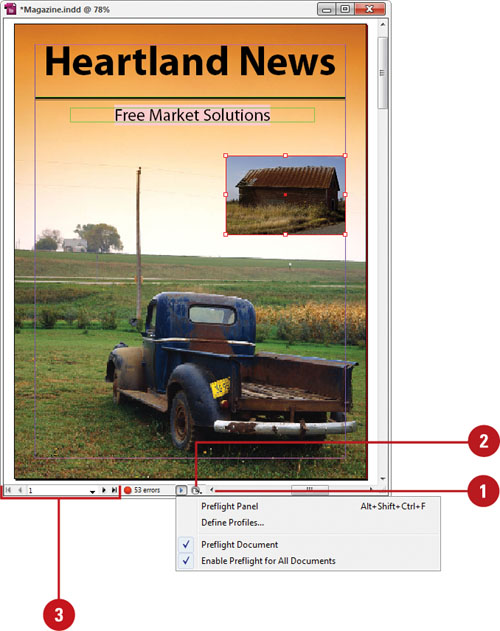
![]() To locate the current document in Explorer, Finder, or Bridge, click the Open menu, and then click Reveal in Explorer (Win) or Reveal in Finder (Mac), or Reveal in Bridge.
To locate the current document in Explorer, Finder, or Bridge, click the Open menu, and then click Reveal in Explorer (Win) or Reveal in Finder (Mac), or Reveal in Bridge.
![]() To switch between pages, use any of the following:
To switch between pages, use any of the following:
• First or Last. Displays the first or last page.
• Previous or Next. Displays the previous or next page.
• Page Navigation. Displays the specified page.
Working with Document Windows
When you open multiple documents, you can use the Arrange Documents or Window menu or tabs at the top of the Document window to switch between them. You can click a tab name to switch to and activate the document. By default, tabs are displayed in the order in which you open or create documents. When you want to move or copy information between documents, it’s easier to display several document windows on the screen at the same time and move them around. However, you must make the window active to work in it. Each tab also includes a Close button to quickly close a document. If the document view is too small or large, you can change it to suit your needs.
Work with Multiple Documents
![]() Open more than one document.
Open more than one document.
![]() Click a tab name to switch to the document.
Click a tab name to switch to the document.
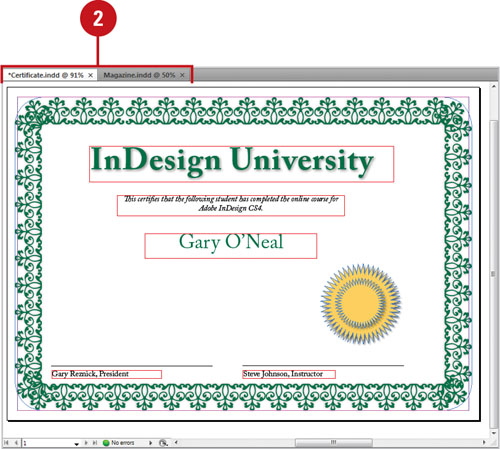
Timesaver
Press Ctrl+Tab or Ctrl+Shift+Tab to cycle to the tab you want.
• You can also click the Window menu, and then click a document name at the bottom of the menu.
![]() To move a document window around, do any of the following:
To move a document window around, do any of the following:
• To rearrange the order of tabbed documents, drag a window’s tab to a new location.
• To switch to another document when dragging a selection, drag the selection over the document’s tab.
• To remove a document from the tabbed documents group, drag a window’s tab away from the tabbed group.

Arrange Multiple Documents
![]() Open more than one document.
Open more than one document.
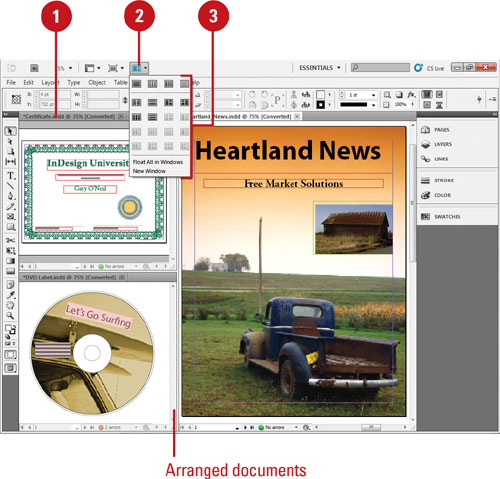
![]() Click the Arrange Documents menu on the Application bar.
Click the Arrange Documents menu on the Application bar.
![]() On the menu, select an arrangement button icon:
On the menu, select an arrangement button icon:
• Consolidate All. Displays all active documents as tabs.
• Tile All In Grid. Displays all open documents in a grid pattern on the screen.
• Tile All Vertically. Displays all open documents vertically on the screen.
• Tile All Horizontally. Displays all open documents horizontally on the screen.
• 2-Up, 3-Up, 4-Up, 5-Up, or 6-Up. Displays the number of documents in the selected pattern (in the menu icon) on the screen.
• Float All in Windows. Displays all open windows in separate undocked floating windows.
• New Window. Creates a new window with the contents of the active window.
![]() To dock or undock a document window, drag the window’s tab out of the group or into the group.
To dock or undock a document window, drag the window’s tab out of the group or into the group.
Checking for Updates Online
As time passes, InDesign—like any other program—will change. There are two types of changes to a program: updates and patches. Updates are improvements to a program such as a new feature, option, or command. Patches are software fixes for problems discovered after the public release of the program. The good news is that both updates and patches are free, and once downloaded, are self-installing. Adobe gives you two ways to check for changes. You can check manually by going to the Adobe web site, or automatically through the Adobe Updater. The Adobe Updater Preferences dialog box allows you to set update options for InDesign and other installed Adobe products, such as Bridge. You can also set an option to have Adobe notify you of updates in the menu bar (New!).
Check for Updates Directly from the Internet
![]() Open your Internet browser.
Open your Internet browser.
![]() Go to the following Web address: www.adobe.com/downloads/updates/
Go to the following Web address: www.adobe.com/downloads/updates/

![]() Click the list arrow, and then click InDesign - Macintosh or InDesign - Windows.
Click the list arrow, and then click InDesign - Macintosh or InDesign - Windows.
![]() Click Go.
Click Go.
Any updates or patches appear in a list.
![]() Based on your operating system, follow the onscreen instructions to download and install the software.
Based on your operating system, follow the onscreen instructions to download and install the software.
Important
Checking on your own requires a computer with a connection to the Internet. Since some of the updates can be rather large, it’s recommended you have high-speed access.
Check for Updates from the InDesign Help Menu
![]() Click the Help menu, and then click Updates.
Click the Help menu, and then click Updates.

Adobe checks your software with the latest available version and automatically updates it.
![]() To manually check, click the Check For New Updates button.
To manually check, click the Check For New Updates button.

![]() To change preferences, click Preferences, select the update options you want, and then click Done.
To change preferences, click Preferences, select the update options you want, and then click Done.

![]() Click Quit.
Click Quit.
Did You Know?
You can deactivate or activate InDesign to use on another computer. You can use your serial number on only one computer at a time. If you’re moving from one computer to another, you can deactivate your serial number on one computer and then activate it another one. Click the Help menu, click Deactivate, click Suspend Activation (saves serial number) or Deactivate Permanently (removes serial number), and then click Done. To activate it, click the Help menu, click Activate, and then follow the instructions.
You can complete or update your Adobe ID profile. An Adobe ID allows you to access Adobe online services. To complete or update your Adobe ID profiles, click the Help menu, click Complete/Update Adobe ID Profile, and then follow the online instructions.
Getting Help While You Work
At some time, everyone has a question or two about using a program. When you start InDesign Help, the Adobe Community Help window opens (New!), displaying help categories and topics. You can search product help from Local Help, Community Help, or Adobe.com by using keywords or phrases or browsing through a list of categories and topics to locate specific information. Local Help accesses product help on your local computer, Community Help accesses product help online, and Adobe.com accesses related help information on Adobe.com. When you perform a search using keywords or phrases, a list of possible answers is shown from the search location with the most likely responses at the top. Along with help text, some help topics include links to text and video tutorials. In addition, comments and ratings from users are available to help guide you to an answer. You can add feedback and suggestions by signing in to Adobe.com using an Adobe ID.
Get Help Information
![]() Click the Help menu, and then click InDesign Help.
Click the Help menu, and then click InDesign Help.

Timesaver
Press F1 (Win) or ![]() +/ (Mac).
+/ (Mac).
The Adobe Community Help window opens, displaying product help information.
![]() Click Help categories (plus sign icons) until you display the topic you want.
Click Help categories (plus sign icons) until you display the topic you want.

![]() Click the topic you want.
Click the topic you want.
![]() Read the topic, and if you want, click any links to get information on related topics or definitions.
Read the topic, and if you want, click any links to get information on related topics or definitions.
![]() When you’re done, click the Close button (Win) or click the Adobe Help menu (Mac), and then click Quit Adobe Help.
When you’re done, click the Close button (Win) or click the Adobe Help menu (Mac), and then click Quit Adobe Help.
Did You Know?
You can get resource help with InDesign on the Web. Click the Help menu, click Welcome Screen, and then click Resources or InDesign Exchange to display InDesign help resources from all over the Web.
Search for Help Information
![]() In InDesign, on the Application bar, type one or more keywords in the Search box, and then press Enter (Win) or Return (Mac).
In InDesign, on the Application bar, type one or more keywords in the Search box, and then press Enter (Win) or Return (Mac).
• You can also click the Help menu, and then click InDesign Help to open Help and use the Search box.

The Adobe Community Help window opens, displaying a list of topics that match the keywords you entered in the Search box.
![]() To search another CS product, click the Select Product list arrow, and then select a CS product.
To search another CS product, click the Select Product list arrow, and then select a CS product.

![]() To refine a search, click Search Options to expand it, and then select any of the following options:
To refine a search, click Search Options to expand it, and then select any of the following options:
• Search This Help System Only. Select to constrain the search to the selected product.
• Search Location. Select Local Help, Community Help, or Adobe.com.
• Filter Results. For Adobe.com, select a filter option.
![]() Click the link to the topic you want from the search list of results.
Click the link to the topic you want from the search list of results.
• What’s New. Click the plus sign (+) next to Resources, and then click What’s New.
![]() Read the topic, and if you want, click any links to get information on related topics or definitions.
Read the topic, and if you want, click any links to get information on related topics or definitions.
• Next and Previous Topics. Click the Previous or Next button on the right side of the Help web page.
![]() When you’re done, click the Close button (Win) or click the Adobe Help menu (Mac), and then click Quit Adobe Help.
When you’re done, click the Close button (Win) or click the Adobe Help menu (Mac), and then click Quit Adobe Help.
Saving a Document
When you finish working on your InDesign document, you need to save it before you close the document or exit InDesign. You can save an InDesign CS5 document in the programs default file format (INDD) or as a template in the default template format (INDT). A template is a special document that makes it easier to create a new document. You might want to change the type if you’re creating a custom template or sharing files with someone who doesn’t have the Adobe InDesign program. When you open an InDesign CS4 document, the document tab includes “[Converted].” A converted document in InDesign CS5 acts like an untitled document, which you need to save to update it. You cannot save the CS4 document in the CS4 document format. If you’re saving large documents to PDF (Portable Document Format) or IDML (InDesign Markup), you can continue to work on your document as InDesign works in the background (New!).
Save an InDesign Document
![]() Click the File menu, and then click Save (for an untitled or converted document) or Save As.
Click the File menu, and then click Save (for an untitled or converted document) or Save As.
• When you click Save for an InDesign CS5 document, the file is saved with it’s current name and in the same location.
![]() Enter a name for the file.
Enter a name for the file.
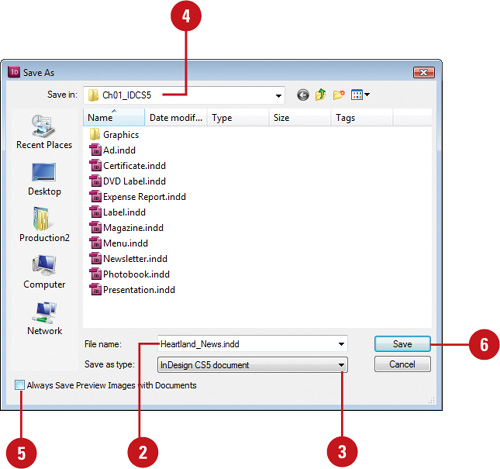
![]() Click the Save as Type list arrow (Win) or Format popup (Mac), and then click InDesign CS5 document.
Click the Save as Type list arrow (Win) or Format popup (Mac), and then click InDesign CS5 document.
![]() Navigate to the location where you want to save the document.
Navigate to the location where you want to save the document.
![]() Select the Always Save Preview Images with Documents check box to save a preview image with the document for use in dialog boxes and thumbnails as a preview.
Select the Always Save Preview Images with Documents check box to save a preview image with the document for use in dialog boxes and thumbnails as a preview.
![]() Click Save.
Click Save.
Did You Know?
You can save all open documents. Press Ctrl+Alt+Shift+S (Win) or ![]() +Option+Shift+S (Mac) to save all open documents to their existing locations and filenames.
+Option+Shift+S (Mac) to save all open documents to their existing locations and filenames.
Save a Copy of an InDesign Document
![]() Click the File menu, and then click Save A Copy.
Click the File menu, and then click Save A Copy.
![]() Enter a name for the file or use the default original name with the word “copy” at the end.
Enter a name for the file or use the default original name with the word “copy” at the end.

![]() Click the Save as Type list arrow (Win) or Format popup (Mac), and then click InDesign CS5 document.
Click the Save as Type list arrow (Win) or Format popup (Mac), and then click InDesign CS5 document.
![]() Navigate to the location where you want to save the document.
Navigate to the location where you want to save the document.
![]() Select the Always Save Preview Images with Documents check box to save a preview image with the document for use in dialog boxes and other thumbnails as a preview.
Select the Always Save Preview Images with Documents check box to save a preview image with the document for use in dialog boxes and other thumbnails as a preview.
![]() Click Save.
Click Save.
Did You Know?
You can save a document as a template. Click the File menu, click Save As, click the Save As Type (Win) or Format (Mac) popup, click InDesign CS5 Template, enter a name, specify a location, and then click Save.
You can revert to the last saved version. Click the File menu, and then click Revert.
Finishing Up
After you work on a document, you can finish up by closing the document or by exiting InDesign. You should save the document before closing it. Exiting InDesign closes the current document and the InDesign program and returns you to the desktop. You can use the Exit command on the File menu (Win) or Quit InDesign command on the InDesign menu (Mac) to close a document and exit InDesign, or you can use the Close button on the InDesign Document tab. If you try to close a document without saving your final changes, a dialog box opens, asking if you want to do so.
Close a Document
![]() Click the Close button on the Document tab, or click the File menu, and then click Close.
Click the Close button on the Document tab, or click the File menu, and then click Close.

Timesaver
Press Ctrl+W (Win) or ![]() +W (Mac) to close a document.
+W (Mac) to close a document.
![]() If necessary, click Yes to save any changes you made to your open documents before the program quits.
If necessary, click Yes to save any changes you made to your open documents before the program quits.
Exit InDesign
![]() Choose one of the following:
Choose one of the following:
• Click the Close button, or click the File menu, and then click Exit (Win).
• Click the InDesign menu, and then click Quit InDesign (Mac).

Timesaver
Press Ctrl+Q (Win) or ![]() +Q (Mac) to exit InDesign.
+Q (Mac) to exit InDesign.
![]() If necessary, click Yes to save any changes you made to your open documents before the program quits.
If necessary, click Yes to save any changes you made to your open documents before the program quits.
